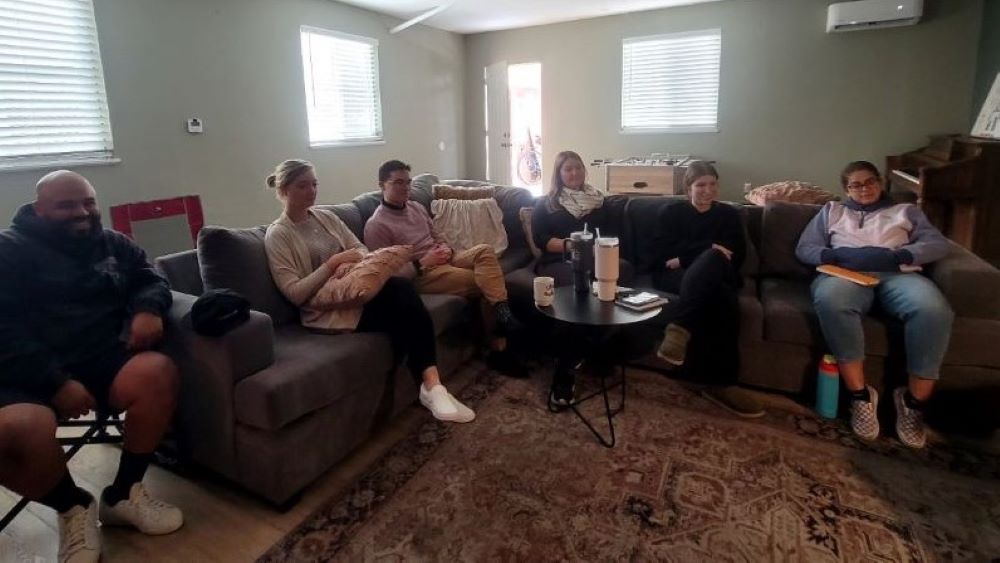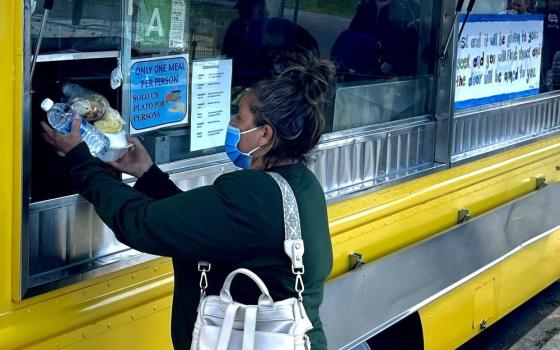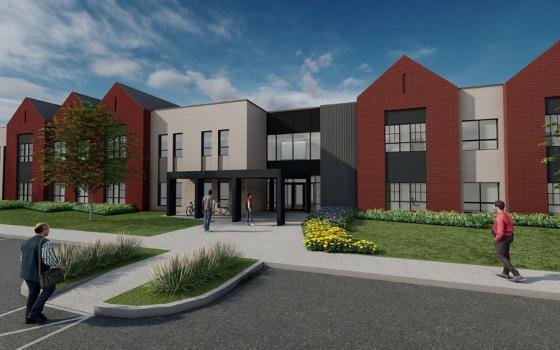
Claire McManmon teaches social studies on a recent afternoon at St. Martin of Tours School in San Jose, California. The 28-year-old pays $1,000 a month to live in a former parish convent; the average cost of a one-bedroom apartment in the region is more than double that amount. (Courtesy of Claire McManmon)
Claire McManmon did not become a Catholic school educator for a massive paycheck, but she also hoped she wouldn't have to scramble to cover rent.
So when the 28-year-old's sister and brother-in-law encouraged her to move from the Midwest to San Jose, California, she was hesitant. The average monthly cost of a one-bedroom apartment in the notoriously pricey Silicon Valley is more than $2,400.
"That would be hard to budget for any teacher, much less a Catholic school teacher," McManmon told NCR.
Around the country Catholic schools are struggling to retain and recruit educators, and real estate experts and church leaders say the reasons include escalating housing prices, particularly in coastal states and urban areas.
To help tackle the challenges, a fledgling movement is underway to provide affordable housing to Catholic school instructors. Several U.S. dioceses are considering or have launched initiatives, with early projects focused on revamping the church's extensive and often underutilized real estate.
McManmon ultimately moved to San Jose and landed what she called "the perfect setup" — a job teaching at St. Martin of Tours School and paying $1,000 a month for communal housing in a renovated convent at nearby St. John Vianney Parish.
'A moral obligation'
Multiple reports indicate teacher shortages, which experts say impact public and Catholic schools alike, have worsened in recent years.

Lincoln Snyder, president and CEO of the National Catholic Educational Association, said "reimagining how we can support people coming into teaching is one of the top priorities for the church." (Courtesy of National Catholic Educational Association)
There are myriad reasons for the trend, including burnout and relatively low salaries.
"I don't think housing is the biggest problem, but it's one aspect of it, and it's a big point of angst especially for younger teachers," said Lincoln Snyder, president and CEO of the National Catholic Educational Association.
Fr. Joe Kim, pastor of St. John Vianney, said the steep cost of housing is "very likely the No. 1 challenge" in attracting and retaining young educators in the San Jose Diocese.
As housing costs swell, wages across the workforce haven't kept pace.
Many public school teachers struggle to afford housing close to where they work, and it can be even more difficult for Catholic educators, who make on average 26% less than their public school counterparts, according to data from the National Center for Education Statistics.
"Catholic school teachers have always earned a relatively modest income, but in most places, a young couple teaching 20 or 30 years ago could still expect to get a house," Snyder said.
'The stats don't lie, and you could argue that we're falling behind in caring for Catholic school teachers.'
—Joe Womac
A hurdle to paying teachers more, according to Catholic school leaders, is that tuition and salaries are closely linked. In K-8 schools, about 80% of tuition goes toward staff wages, according to Snyder, and schools try to keep instruction costs affordable for working families.
Joseph Womac is president of the Specialty Family Foundation — a nonprofit supporting Catholic education, housing and substance abuse treatment efforts in LA County — and he's been engaged in national conversations about lower-cost housing for Catholic school teachers.
Womac acknowledged the compensation constraints in Catholic schools. "The stats don't lie, however, and you could argue that we're falling behind in caring for Catholic school teachers," he said.
"We have a moral obligation that comes with our Catholic mission," said Womac. "We can't stop at the point of hire and just say, ‘You know, I made this hire, and it's your job to be here.' "
New life to an old concept
The Catholic Church has housed teachers before, "they just wore habits," said Benjamin Vasko, Catholic school recruitment specialist for the St. Paul and Minneapolis Archdiocese.
Vasko was speaking at a conference in the fall sponsored by the Church Properties Initiative at the University of Notre Dame's Fitzgerald Institute for Real Estate. The initiative aims to help the Catholic Church — viewed as the world's largest non-state landowner — address real estate issues. It recently has become a resource for a growing group of dioceses interested in affordable housing for Catholic school teachers.

At St. Alphonsus Parish in Seattle, a convent once home to the Society of Our Lady of the Most Holy Trinity Sisters now houses Catholic school educators. Several U.S. dioceses are considering ways to repurpose their real estate into affordable housing for Catholic school teachers. (Courtesy of the Seattle Archdiocese)
Migration to the suburbs, parish consolidations, and fewer people entering the priesthood and religious life have left a sizable quantity of underused and vacant properties, said Maddy Johnson, program manager for the Church Properties Initiative.
Womac said people involved in Catholic education are exploring ways "to be strategic and creative with land holdings so that the church can do more for housing without necessarily having to find a lot of cash to do it."
In June, the Church Properties Initiative and Notre Dame's Alliance for Catholic Education (ACE) hosted a summit with Catholic school superintendents, including delegates from St. Paul and Minneapolis, Chicago, Los Angeles and Brooklyn, New York, to discuss ways to use real estate for educators.
In addition to the church's history of housing men and women religious who staff Catholic schools, for years a number of university-based graduate-degree programs for Catholic school teachers have offered low-cost housing. Examples include ACE and Partners in Los Angeles Catholic Education (PACE Corps) at Loyola Marymount University. Womac said such programs can serve as helpful models for the new projects.
Dioceses are discussing a range of options, including converting unused rectories and convents into intentional communities — a model similar to the graduate-degree programs — and mortgage rebates, the lease or sale of property to subsidize teacher housing, and construction of new affordable housing on church land.
Most initial efforts involve revamped former convents, where the floor plan lends itself to communal living — a lifestyle that's typically more appealing and practical for young, single people.
Solutions for people with growing families or who are ready for home ownership are more challenging, said education and housing experts, but they hope projects emerge.

Catholic professionals, including teachers, gather for fellowship in the top story of a former convent in San Jose, California. Communal living and low-cost housing provide the "perfect setup," said Claire McManmon, who teaches fifth through eighth graders at a nearby Catholic school. (Courtesy of St. John Vianney Parish)
Community and lower costs
At St. John Vianney, the bottom floor of its former convent — once home to Presentation sisters who taught parish schoolchildren — contains parish offices, but for years the top floor was "basically a storage unit," said Kim, the pastor. "I was told that for real estate agents," wasting that space "was like a mortal sin."
The building required relatively modest upgrades in order to welcome residents — a kitchen remodel and new fans, flooring, paint and blinds, and a plumbing system inspection.
The renovation cost approximately $300,000 and took three months. Like other recent teacher housing projects, it was financed largely by a foundation.
Johnson, at the Church Properties Initiative, noted that repurposing property can be complicated and, in certain cases, expensive. In deciding how to proceed, owners need to consider many factors, including the building's structural soundness and its architectural significance.
Inside the converted San Jose convent, a married couple serve as coordinators and live in the former mother superior's quarters. The 12 residents are a mix of young Catholic professionals and include public as well as Catholic school teachers.
The parish charges $1,000 a month for what it calls "stewardship," rather than rent, and will work with residents to lower the amount if needed. Individuals are asked to stay for a year, but the timeline is flexible.
Residents commit to eat and pray together, "not all the time but regularly," Kim said.

Jon Martin, coordinator for residents in the transformed convent at St. John Vianney Parish, leads music in the chapel. He and his wife help organize meals, prayer and social functions. (Courtesy of St. John Vianney Parish)
School leaders emphasized that the benefits of an intentional community can further help young educators remain in the career longer.
For McManmon, who taught for two years before moving to San Jose, the ability to interact with other teachers at home "is really helpful for the development and growth of me as an educator."
"You share ideas or stories and you encourage each other," she said.
Transforming former convents into "something close to their original purpose by filling them with young, passionate teachers, brings life to a community," Kim said. "It certainly has for us."
At least two programs that will include affordable housing strongly emphasize a formation element, including efforts in the St. Paul and Minneapolis and Denver archdioceses. The Colorado initiative seeks to create "mission-aligned teachers" by providing mentoring and formation to recent college graduates.
A project in the Seattle Diocese aims to transition underutilized church spaces into affordable housing for church employees, and the first year focuses on Catholic school educators.
The diocese renovated a convent in Seattle's St. Alphonsus Parish for about $30,000. Currently there are five residents, who pray and eat together, and each pay $900 per month. The average monthly rate for a one-bedroom apartment near the parish was approximately $1,725 in February.
"Our hope is to expand the program to provide the necessary support to teachers in those beginning years when the salary is not commensurate to the rental rates in the area," said Helen McClenahan, chief communication officer for the archdiocese.
Advertisement
Affordable housing for Catholic school teachers based on new construction may emerge first in the Los Angeles Archdiocese.
The Specialty Family Foundation helped establish the Our Lady Queen of Angels Housing Alliance in 2023 — Los Angeles Archbishop José Gomez is board chair — to address the housing crisis in part by developing affordable housing on archdiocesan property. (A California law signed in October aims to give faith organizations the ability to more easily build affordable homes; it likely will mean fewer hurdles for the alliance's work.)
Our Lady Housing's first endeavor is a 100-unit building to house at-risk community college students. But future projects will focus on Catholic school staff.
McManmon, taking a quick morning break from teaching, said it's going to "continue to be difficult to find people who are willing to find the beauty in teaching to be greater than the reality of the costs."
"To have opportunities to obtain affordable housing," she said, "I think will be a key part of having young Catholic educators in our country."
[This article was made possible by a grant from the Hilton Foundation.]







